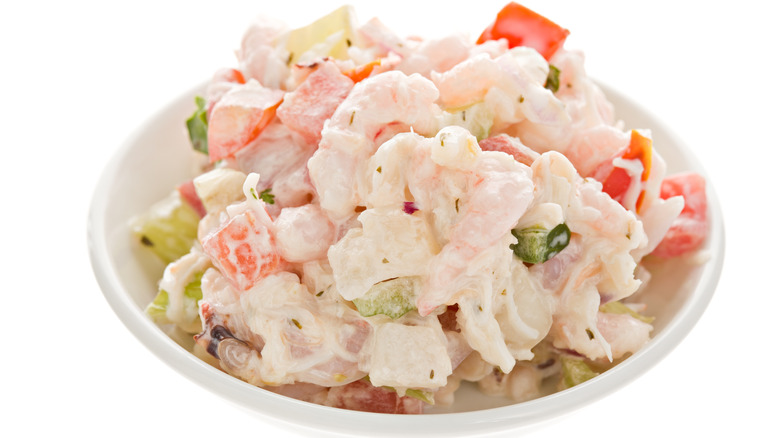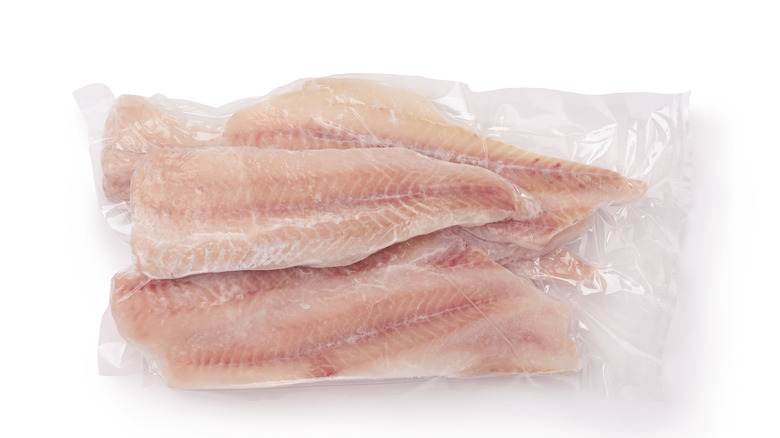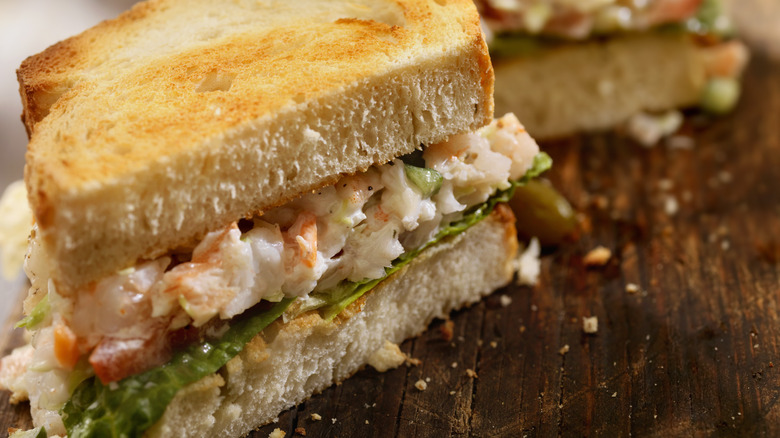You Need To Think Twice Before Freezing That Leftover Seafood Salad
Seafood salad is one of the ultimate satisfying cold foods. You can make it with all kinds of ingredients like lobster, mussels, or octopus, depending on what's available and in season, and flavor it with almost any kind of herbs and spices. It's perfect for dinner on a hot summer night, and you don't have to heat it if you're taking it to the office for lunch. Once you assemble your salad or buy it pre-made at the grocery store, however, you've got to eat it right away, because cooked seafood only lasts in the refrigerator for a few days, and seafood salad doesn't freeze well at all.
Seafood tends to be pretty expensive, so you might think you can freeze a container or two of salad to stretch its lifespan out a little. Unfortunately, while you can technically store frozen fish in the freezer indefinitely, when you thaw your salad later it's going to be a mess, both in texture and in taste, because the freezer is very hard on cooked seafood, salad dressings, and mayonnaise, and fresh vegetables — basically all the components of your salad.
Most seafood has already been frozen once
One of the biggest reasons why you shouldn't freeze seafood salad, or any seafood that's already cooked, is because most seafood has been frozen before it gets to your plate, even the uncooked stuff from the seafood counter. This is because almost all of the fish we buy is flash-frozen on the boat before it ever comes ashore as most big commercial fishing boats are out at sea for an extended length of time.
In general, all perishable food should be handled properly, but seafood is particularly delicate and carries more risks than, say, chicken breast, because if fish isn't properly stored it can cause scombroid fish poisoning. The U.S. Food and Drug Administration also recommends that fresh fish should only be stored in the refrigerator for two days before it needs to be cooked, while the USDA recommends eating cooked seafood within three to four days.
So unless you bought your seafood directly from the fisherman, or from a reputable fishmonger, who can say for certain that your fish came from a "day boat," it was likely frozen before it got to you because that is the safest way to store seafood before it is sold. The flesh of most fish is pretty delicate, however, and freezing a batch of seafood salad would mean you're freezing the fish a second time, which will ruin the texture.
Mayonnaise and veggies don't freeze either
Aside from the fish suffering from freezing, the ingredients you use to make your seafood salad also don't like the freezer. Mayonnaise, in particular, doesn't survive the freezing and thawing process because it's an emulsion of egg, vinegar, and oil. When it thaws, that emulsion breaks, creating an oily, acidic mess. This is also true if you use a vinaigrette dressing for your salad.
Seafood salads also often contain fresh vegetables and herbs that don't freeze well, like celery, cucumber, basil, and tarragon, which contain a lot of water. While their flavors will mostly survive, their texture will be significantly changed, and instead of a nice, crispy crunch of fresh celery, the chopped bits will be soggy and wet, for example. Fresh basil will also turn brown and look slimy.
The best way to store seafood salad, really, is to not store it at all. Plan to only buy as much seafood or pre-made salad as you think you'll eat in a couple of days. Seafood and mayonnaise both take well to a lot of flavors, so you can break up a larger batch into smaller, lunch-size portions and season them several different ways if you buy seafood in bulk. You can also try adding some pickle juice or other flavors to jazz up pre-made salads. Just avoid the freezer and use it as an excuse to eat more yummy, fresh seafood before it goes bad.


